The 2018 Apple iPad Pro (11-Inch) Review: Doubling Down On Performance
by Brett Howse & Andrei Frumusanu on December 4, 2018 10:00 AM ESTThe Liquid Retina Display
Apple offers some of the best displays on the market, and the iPad Pro is arguably their best display available. What Apple calls a Liquid Retina display is a 264 pixel-per-inch masterpiece. The 11-inch model we are reviewing holds a 2388x1668 7:5 aspect ratio panel, while the larger 12.9-inch model uses a 4:3 2732x2048 panel.
There’s a lot that sets Apple apart from other manufacturers on the market. The company has taken display accuracy seriously longer than anyone outside of the professional field. The display in the iPad Pro is also a P3 D65 gamut display, but thanks to the color management system that Apple moved over from the Mac, it simultaneous offers near-perfect sRGB reproduction as well as near-perfect P3 reproduction whenever an app or image specifically says it's P3. There’s no compromise on offering the P3, and no need to change the gamut on the display to match different color spaces. It’s a P3 display where sRGB is properly mapped.
In addition, Apple’s iPad Pro offers their ProMotion technology, which means it is a 120 Hz display, but one that supports variable refresh rates in order to lower the display's refresh rate for power management purposes. The iPad Pro will go as low as 24 Hz, presumably chosen to match the framerate of most movies. Apple also carries over its True Tone functionality, where ambient light sensors change the white point of the display to make it more suited to the environment it is in. It’s one of those features you never really knew you needed until you see it in action.
The fully laminated display also offers Apple’s industry leading antireflective coating, which Apple rates at 1.8% reflectivity, improving the results outdoors dramatically over most devices, and of course there is a fingerprint-resistant oleophobic coating as well.
Apple rates the latest iPads at up to 600 nits of brightness too, so pretty much no matter where you are, the combination of the high brightness and the antireflective coating should make for a great viewing experience.
To test the display characteristics, we turn to SpectraCal’s CalMAN software suite, along with an X-Rite i1Display Pro colorimeter for brightness and contrast readings, and the X-Rite i1Pro 2 spectrophotometer for color accuracy readings.
Brightness and Contrast
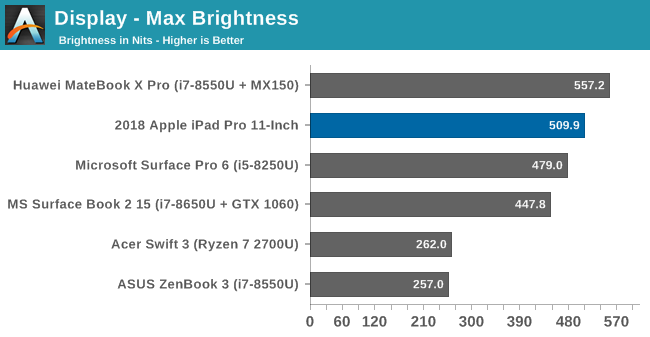
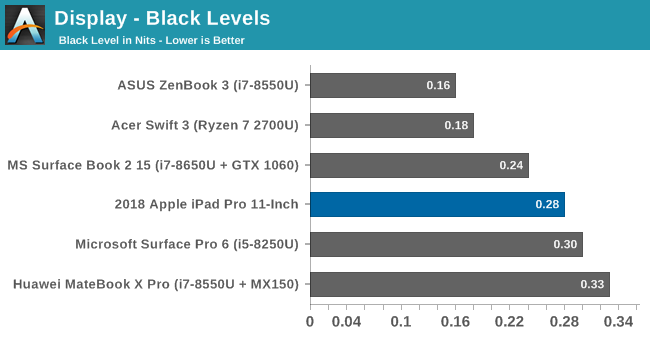
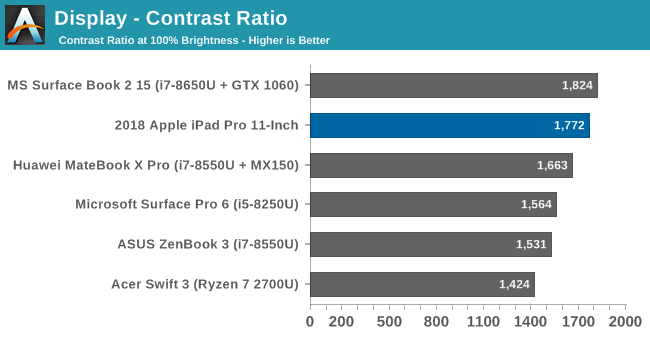
Under our test conditions the iPad Pro could not quite hit the 600 nits that Apple advertises, but at 500 nits it is still plenty bright. Couple that with the excellent contrast ratio of almost 1800:1, and things are off to a good start.
Grayscale
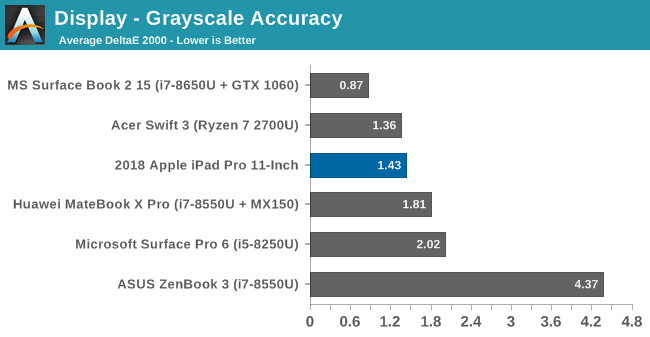
The average dE2000 of 1.43 is a fantastic result, but the gamma isn’t quite perfect, dropping off near 100% because the display was slightly too bright. Unfortunately, the red results were quite low throughout the entire range leading to a slightly cooler display white point, but this is all quite minor.
Gamut
First let’s take a look at sRGB:

As you can see, the sRGB values are almost perfectly mapped into the P3 D65 gamut, and the average error level of just over 1.09 is simply fantastic. All of the primary and secondary values are close to perfect, except red which was a bit low at 100% red, as we saw in the grayscale results.
Next up, P3 D65:
As with the sRGB results, the P3 D65 gamut is also almost perfect. The beauty of color management means that there’s no work for the user to get the benefit of both P3 and sRGB.
Saturation

The saturation sweep was run in sRGB, and as you can see from the graphs, all along all of the primary and secondary colors the error level is basically imperceptible to the human eye.
Gretag Macbeth
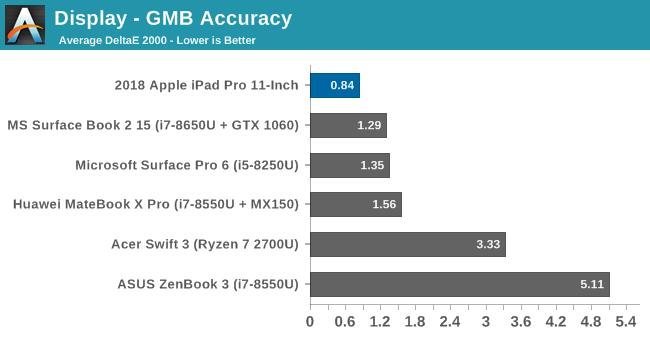
Finally, the Gretag Macbeth test is a more comprehensive test, hitting colors outside of the primary and secondary colors, including the important skin tones. The error level is practically perfect, with no single color even hitting an error level of 2.0.
Display Conclusion
The iPad Pro simply offers one of the best displays on any electronic device. Color accuracy is superb, in both the P3 and sRGB gamuts, and thanks to iOS supporting full color management, customers don’t have to worry about if they are working on a P3 or sRGB image. The addition of True Tone makes for an incredibly pleasing white point in pretty much any situation, and the 120 Hz display refresh rate makes for smooth scrolling, while stepping down to lower refresh rates to conserve power when the display is static.


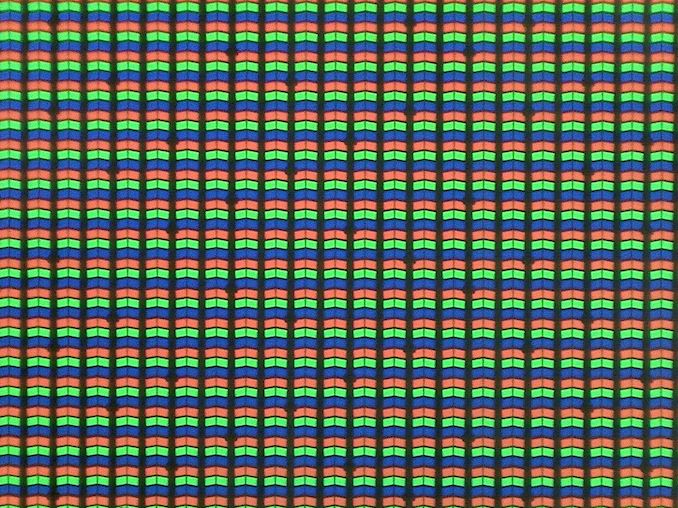


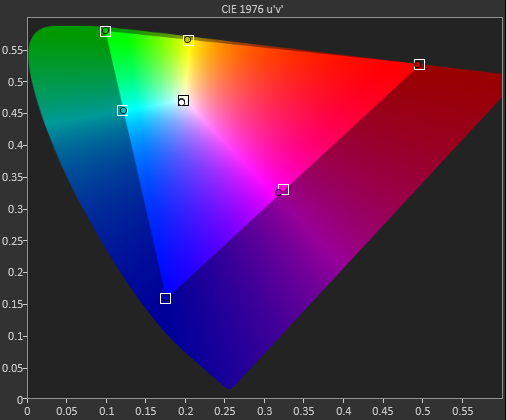










145 Comments
View All Comments
thunng8 - Wednesday, December 5, 2018 - link
Yes, way ahead of Core M, especially for graphics. Something like 5-6X faster in gfxbench.Brett Howse - Wednesday, December 5, 2018 - link
There's a few results in there already from the MacBook Air with Y Series.name99 - Wednesday, December 5, 2018 - link
The most interesting thing, to me, is the cache topology.While everyone else at the high end has been retreating to private L2 caches, and a large shared L3, Apple has doubled down on a
- LARGE L2 that's
- shared by at least 4 clients
with L3 acting more as the communications/sharing space between different blocks like CPU, GPU, ISP, NPU.
Clearly it's working for them! It also suggests that when they scale even larger (the inevitable ARM Macs and [internal use] servers) they'll likely ship something that looks very different from not just Intel's high end (private L2, distributed L3 slice per core) but perhaps also the current ARM servers?
Do we know anything at all about the NoC that's in use on Apple SoCs, and, second best, on other ARM SoCs (eg QC, Samsung)? A ring? A crossbar? Point to point with direct links from each block to L3, but no block-to-block communication?
Railgun - Wednesday, December 5, 2018 - link
These reviews lately are killing me. Zero consistency from chart to chart. Why in one metric are we comparing a tablet to phones, and others to other tablets...and nada against its predecessor? There are so many reviews like this.Brett Howse - Wednesday, December 5, 2018 - link
Some of the tests are mobile only.Some of the tests are not.
This device bridges both so why would we not compare it to both?
Socius - Wednesday, December 5, 2018 - link
Charging time with a proper adapter is insanely fast on the iPad pro. Using a 20,000mah battery pack, I was able to charge it up from 3% to 45% in about 30-35 minutes. That is absolutely incredible.Also, you can change the tip on the Apple Pencil as it is a simple screw off design. Apple itself doesn't sell different tips but I'm sure 3rd party would step in pretty soon.
One thing you didn't cover is the disk read/write performance. And it differs greatly based on which model iPad you get. The 12.9" 1TB WiFi model is substantially faster than other capacities. And the extra ram has helped keep apps/games in memory far longer than they would on my XS Max with its 4GB ram.
We'll be able to better compare the productivity performance of the iPad Pro once the full Photoshop CC port is released in 2019. But in the mean time, I'm editing through 4K videos using LumaFusion like it's nothing. This isn't a desktop. But with the right apps, it can come pretty close to being able to handle 90% of your workflow. In such a small and portable package. I find myself designing websites on it while sitting on the couch. The drag-and-drop feature between application windows in split view is such a big help as well.
Overall, I picked the iPad Pro over the Surface Pro due to the 120Hz display. And once Photoshop is ported over in a few months, I'll be able to do so much more of my work on it. I think my only gripe is that Microsoft Office is so weak on the iPad Pro. If only I had access to the full desktop version.
lilo777 - Wednesday, December 5, 2018 - link
1. Don't work on your couch.2. iPad does not have 120Hz display
darklight69 - Thursday, December 6, 2018 - link
1. He/She can work wherever they feel like. What kind of control freak are you to demand otherwise from complete strangers.2. Yes it does, says so in the review's display section - https://www.anandtech.com/show/13661/the-2018-appl...
"In addition, Apple’s iPad Pro offers their ProMotion technology, which means it is a 120 Hz display, but one that supports variable refresh rates in order to lower the display's refresh rate for power management purposes."
WasHopingForAnHonestReview - Wednesday, December 5, 2018 - link
Nonsense. How much are you paid for this co?mmentSocius - Thursday, December 6, 2018 - link
Which part of what I said do you disagree with or find questionable?